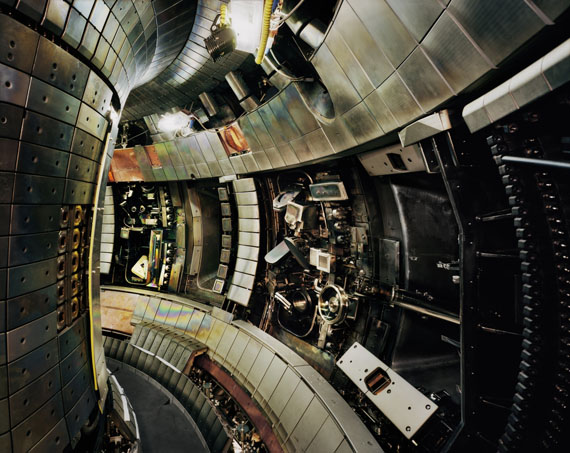
Tokamak Asdex Upgrade Interior 2, Max Planck IPP, Garching, 2009
Chromogenic print
141,6 x 176,0 cm
Courtesy: Museum Folkwang, Essen
© Thomas Struth
Thomas Struth »
Nature & Politics
Exhibition: 11 Jun – 18 Sep 2016
Fri 10 Jun 19:00
Martin-Gropius-Bau
Niederkirchnerstr. 7
10963 Berlin
Wed-Mon 10-19
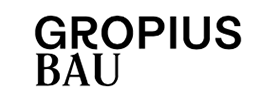
Gropius Bau
Niederkirchnerstr. 7
10963 Berlin
+49 (0)30-254860
post@gropiusbau.de
www.gropiusbau.de
Mon, Wed-Fri 12-19, Sat, Sun 10-19
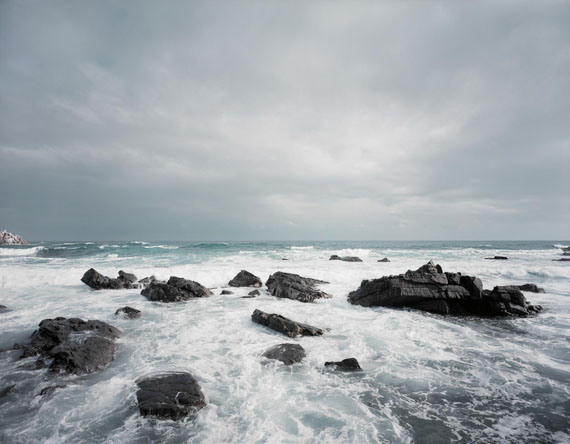
Seestück, Donghae City 2007
Chromogenic print
167,5 x 212,2 cm
© Thomas Struth
Thomas Struth
"Nature & Politics"
Exhibition: 11 June – 18 September 2016
Thomas Struth is internationally considered one of the most important artists of his generation. For the first time, his work will be displayed at the Berliner Martin-Gropius-Bau. The exhibition will feature approximately 37 large-format photographs from the years 2005 through 2016. It is Thomas Struth's first museum exhibition in Berlin.
Industrial production plants, research laboratories and operating rooms, but also everyday architecture or theme parks: Thomas Struth's pictures of the last few years explore how human ambition and imagination become spatial, objective reality.
This ensemble of Struth's work shows us highly complex devices, structures and constructions that define our present, but are usually inaccessible to the public. These pictures tell of attempts to extend the limits of what is technically possible and to exceed natural reality through artificial worlds.
Struth is not only fascinated by complex structures, but by the mental endeavor displayed by them. "I wanted to explore the process of imagination. (...) I am only concerned with how something that at first was only a thought materializes and becomes part of reality. 'Picturing something,' this expression already describes the brain's ability to think in pictures."
The photographs are about highly specialized imagination: Developments in space travel, plasma physics experiments or industrial facilities, such as oil rigs or blast furnaces, are products of the ideas and designs of experts. Struth's detailed photographs show that these overwhelmingly complex constructions are also creations. Created by humans, they raise the question of how power and striving for power is documented in objects and how they then gain political importance. The pictures explore the creation, interpretation and reinterpretation of reality, memory and experience.
Thomas Struth (*1954) is one of the artists who helped photography gain a new intensity and effectiveness. He first studied painting under Gerhard Richter and, after 1976, photography under Bernd and Hilla Becher at the Kunstakademie Düsseldorf. As early as 1992, Struth's work was displayed at the documenta IX in Kassel.
Seeing precisely is at the center of his creative work: whether it's the impenetrable thickets of Asian jungles, large format museum scenes or his latest photographs of places of technical innovation. His pictures of landscapes, streets or museum visitors are like studies depicting historic, functional and social relationships.
This exhibition was made possible by the close cooperation between the artist and the following museums: Museum Folkwang, Essen, High Museum of Art, Atlanta/GA, and Saint Louis Art Museum, St. Louis/MO.�
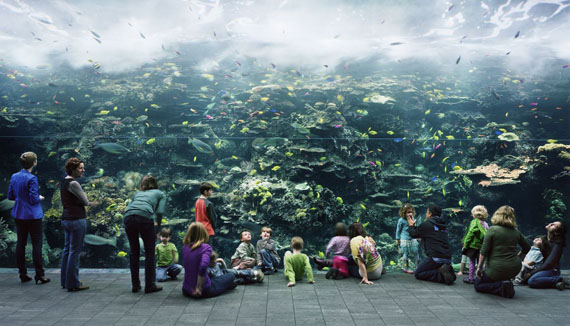
Aquarium, Atlanta 2013
Chromogenic print
207,5 x 357 cm
Courtesy: Museum Folkwang, Essen
© Thomas Struth
Thomas Struth
"Nature & Politics"
Ausstellung: 11. Juni bis 18. September 2016
Thomas Struth zählt zu den international wichtigen Künstlern seiner Generation. Erstmals sind seine Arbeiten im Berliner Martin-Gropius-Bau zu sehen. In der Ausstellung werden 38 großformatige Fotografien aus den Jahren 2005 bis 2016 präsentiert. Es ist Thomas Struths erste umfassende museale Ausstellung in Berlin.
Industrielle Produktionsanlagen, Forschungslabore und Operationssäle, aber auch Alltagsarchitekturen oder Erlebnisparks: Thomas Struth untersucht in seinen Bildern der letzten Jahre, wie menschliche Vorstellungskraft, Ehrgeiz und Wille räumliche, objekthafte Wirklichkeit erschaffen.
Das Ensemble von Struths Arbeiten zeigt uns hochkomplexe Apparaturen, Strukturen und Konstruktionen, die unsere Gegenwart prägen, aber dem Blick der Öffentlichkeit meist unzugänglich sind. Die Bilder erzählen von Versuchen, die Grenzen des technisch Möglichen zu erweitern und mittels künstlicher Welten die natürliche Wirklichkeit zu überbieten.
Struth beobachtet dabei hauptsächlich die geistige Anstrengung, die sich in Spitzentechnologien abbildet. "lch wollte den Prozess der Imagination und Fantasie untersuchen. (. ..) Es geht mir darum, wie etwas, das zuvor nur ein Gedanke war, sich materialisiert und Teil der Wirklichkeit wird. 'Sich etwas ausmalen', dieser Ausdruck beschreibt ja schon die Möglichkeit des Gehirns, in Bildern zu denken."
Die Fotografien handeln von hoch spezialisierter wissenschaftlich-technischen Errungenschaften: Entwicklungen der Raumfahrt, plasmaphysikalische Experimente, Industrieanlagen wie Bohrinseln oder Hochöfen sind Produkte der Ideen und Entwürfe von Experten. Struths detailreiche Fotografien zeigen, dass diese überwältigend vielschichtigen Konstrukte immer gemacht sind. Von Menschen hergestellt, werfen sie die Frage auf, wie Macht und Machtstreben sich in Objekten artikulieren und sich dadurch politische Geltung verschaffen. Die Bilder thematisieren die Erschaffung, Deutung und die Umdeutung von Wirklichkeit, von Erinnerung und Erfahrungen.
Thomas Struth (*1954) gehört zu den Künstlern, die dem Medium Fotografie zu neuer Intensität und Wirkungskraft verholfen haben. Er studierte ab 1973 an der Kunstakademie Düsseldorf, zunächst Malerei bei Gerhard Richter, und ab 1976 Fotografie bei Bernd und Hilla Becher. Struths Arbeiten waren bereits 1992 auf der documenta IX in Kassel zu sehen.
Im Mittelpunkt seines künstlerischen Werks steht das präzise Sehen. Ob das undurchdringliche Dickicht asiatischer Dschungel, ob großformatige Museumsszenen oder die jüngsten Aufnahmen von Stätten technischer Innovation. Seine Aufnahmen gleichen Studien, die historische, funktionale und soziale Zusammenhänge abbilden.
Die Ausstellung ist in enger Zusammenarbeit mit dem Künstler und in Kooperation mit den folgenden Museen entstanden: Museum Folkwang, Essen, High Museum of Art, Atlanta/GA, und Saint Louis Art Museum, St. Louis/MO.�
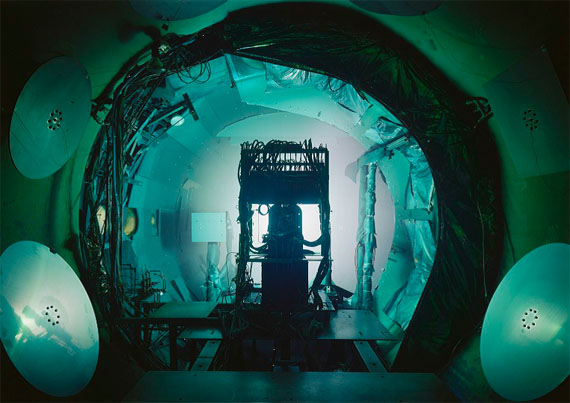
Vacuum Chamber, JPL, Pasadena 2013
Inkjet print
119,8 x 167,4 cm
© Thomas Struth